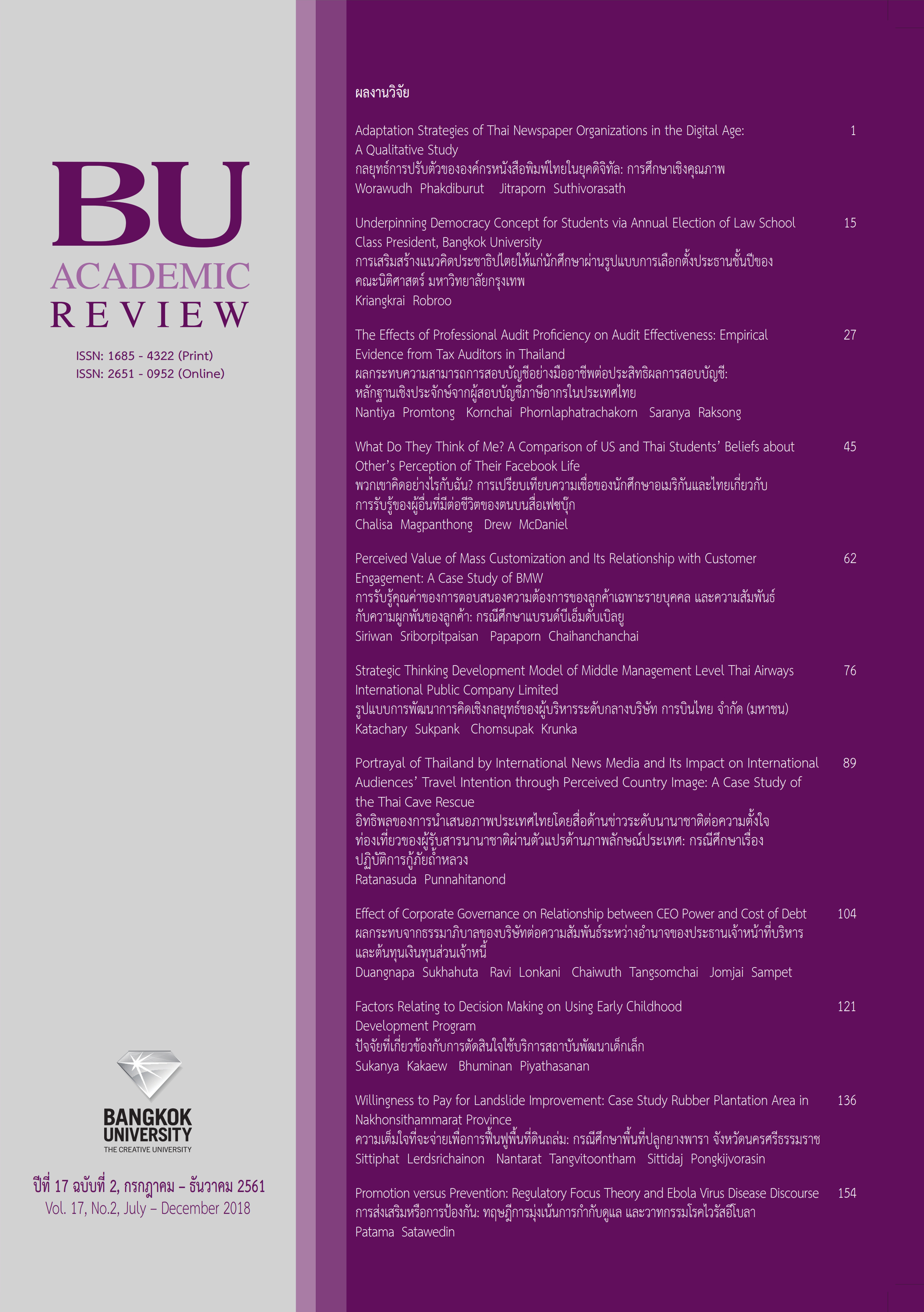ความเต็มใจที่จะจ่ายเพื่อการฟื้นฟูพื้นที่ดินถล่ม: กรณีศึกษาพื้นที่ปลูกยางพารา จังหวัดนครศรีธรรมราช
Main Article Content
บทคัดย่อ
การวิจัยครั้งนี้ศึกษามีความมุ่งหมาย 1. เพื่อประเมินมูลค่าความเต็มใจที่จะจ่ายเพื่อการฟื้นฟูปัญหาดินถล่มและน้ำป่าไหล และ 2. เพื่อหาแนวทางการส่งเสริมคุณภาพสิ่งแวดล้อมในพื้นที่ป่าและสังคมยอมรับ ทั้งเชิงนโยบายทางด้านสิ่งแวดล้อมและเกษตรกรรรม โดยวิธีสมมติเหตุการณ์ให้ประเมินค่า ซึ่งทำการศึกษาโดยการใช้แบบสอบถามเพื่อเก็บข้อมูลด้วยวิธีสัมภาษณ์โดยตรงจากกลุ่มตัวอย่างคือประชาชนที่อยู่ในพื้นที่ดินถล่มจากการปลูกยางพารา บริเวณรอบเขาหลวง จำนวน 380 คน โดยเก็บข้อมูลในช่วงเดือนกุมภาพันธ์ 2561
ผลการศึกษาพบว่า ค่าเฉลี่ยของความเต็มใจที่จะจ่ายเพื่อการฟื้นฟูพื้นที่ป่าเขาหลวง ค่าเฉลี่ยของค่าธรรมเนียมเผื่อใช้ ค่าเฉลี่ยของค่าธรรมเนียมเพื่อลูกหลานในอนาคต และค่าเฉลี่ยของค่าธรรมเนียมเพื่อการคงอยู่ มีค่าเท่ากับ 36.49 36.97 และ 35.38 บาทต่อเดือนต่อครัวเรือน ตามลำดับ ค่ามัธยฐานของความเต็มใจที่จะจ่ายเพื่อการฟื้นฟูพื้นที่ป่าเขาหลวงเท่ากับ 30 บาทต่อเดือนต่อครัวเรือน ส่วนด้านแนวทางส่งเสริมคุณภาพสิ่งแวดล้อมมีการระดมความคิดเห็นภาคประชาชนเชิงปฏิบัติการแบบมีส่วนร่วม ซึ่งความคิดเห็นส่วนใหญ่ต้องการ 1) การมีส่วนร่วมในการจัดการและฟื้นฟูพื้นที่ป่า 2) การจัดการพื้นที่ทำมาหากินอย่างถูกต้องและมีความชัดเจนเชิงนโยบาย และ 3) การสร้างการยอมรับของภาคประชาชน
Article Details
บทความที่นำมาสมัครลงตีพิมพ์ในวารสารต้องไม่เคยได้รับการตีพิมพ์เผยแพร่มาก่อน และไม่ส่งต้นฉบับบทความซ้ำซ้อนกับวารสารอื่น รวมทั้งผู้เขียนบทความต้องไม่ละเมิดหรือคัดลอกผลงานของผู้อื่น
เอกสารอ้างอิง
2559, จาก https://dopa.go.th/main/web_index
กรมทรัพยากรธรณี. (2553). ดินถล่มคืออะไร. สืบค้นเมื่อ 24 สิงหาคม 2558, https://www.dmr.go.th
กรมอุตุนิยมวิทยา. (2531). ปริมาณน้ำฝน สืบค้นเมื่อ 25 เมษายน 2559, จาก
https://www.tmd.go.th/index.php
การยางแห่งประเทศไทย. (2555). ข้อมูลยางพาราในพื้นที่ภาคใต้. สืบค้นเมื่อ 14 มีนาคม 2558, จาก
https://rubber.oie.go.th/ArticleCategory.aspx?acid=6
เครือข่ายธรรมาภิบาลสิ่งแวดล้อมประเทศไทย (2557). คู่มือการมีส่วนร่วมของประชาชนในการประเมินผล
กระทบสิ่งแวดล้อม. กรุงเทพฯ.
เครือพันธ์ ใบตระกูล นิภาพร วัชรสินธุ์; และ อินทิรา เอื้อมลฉัตร. (2545). การวิเคราะห์ผลกระทบสิ่งแวดล้อม.
เศรษฐศาสตร์สิ่งแวดล้อม. นนทบุรี: สำนักพิมพ์มหาวิทยาลัยสุโขทัยธรรมาธิราช.
จุไร ทัพวงษ์. (2545). วิธีการวัดมูลค่าสิ่งแวดล้อมจากการสำรวจและตลาดสมมติ. ในเศรษฐศาสตร์
สิ่งแวดล้อม. กรุงเทพฯ: สำนักพิมพ์มหาวิทยาลัยสุโขทัยธรรมาธิราช.
ชัยวิรัตน์ มุ่งจันทร์. (2552). การศึกษาปัจจัยที่กำหนดและขนาดของความเต็มใจที่จะจ่ายเพื่อบำบัดน้ำเสียใน
คลองแสนแสบ. (ปริญญานิพนธ์เศรษฐศาสตรมหาบัณฑิต, มหาวิทยาลัยศรีนครินทรวิโรฒ).
ณัฐดนัย สันธินันทน์และวัลลภัคร์ พลทรัพย์. (2552). มูลค่าการใช้ประโยชน์และความเต็มใจที่จะจ่าย
ค่าธรรมเนียมของป่าประ กิ่งอำเภอนบพิตำ จังหวัดนครศรีธรรมราช. วารสารจัดการป่าไม้, ปีที่ 3
ฉบับที่ 5, 36-49
ดำรงค์ พิเดช. (2557). รุกป่ายึดที่ดิน สัญญาณร้ายภาคใต้ หมดแล้ว หมดเลย. สืบค้นเมื่อ 15 มีนาคม 2558,
จาก https://landactionthai.org/land/index.php?option=com
ไตรภพ ผ่องสุวรรณ. (2555). นักวิจัยธรณีฟิสิกส์ ม.อ. ชี้ปัจจัยสำคัญทำดินถล่มภาคใต้ แนะวิธีสังเกตพื้นที่เสี่ยง
เพื่อลดการสูญเสีย. สืบค้นเมื่อ 19 มิถุนายน 2558, จาก https://www.psu.ac.th/th/node/4071
พงษ์ศักดิ์ วิทวัสชุติกุล. (2555). สวนยาง ตัวการวิกฤติ ดิน น้ำ ป่า. สืบค้นเมื่อ 14 มิถุนายน 2558, จาก
www.gotomanager.com
เรณู สุขารมณ์. (2550). เอกสารประกอบการสอนวิชา เศรษฐศาสตร์สิ่งแวดล้อม. กรุงเทพฯ:
มหาวิทยาลัยศรีนครินทรวิโรฒ.
วันทนีย์ วัฒนาสุรกิตต์. (2558). การทบทวนสถานการณ์ภัยพิบัต “ดินถล่ม-โคลนถล่ม” ประเทศไทย ปี 2531-
2557. รายงานการเฝ้าระวังทางระบาดวิทยาประจำสัปดาห์. สำนักระบาดวิทยา กรมควบคุมโรค กระทรวงสาธารณสุข
สนธิ วรรณแสงและคณะ. (2541). การวิเคราะห์ผลกระทบสิ่งแวดล้อม. ปทุมธานี: กรมส่งเสริมคุณภาพ
สิ่งแวดล้อม
สมนิมิต พุกงาม. (2557). ความรู้เบื้องต้นและแนวคิดของการประเมินผลกระทบสิ่งแวดล้อม. สืบค้นเมื่อ 5
สิงหาคม 2559, จาก www.arts.kmutt.ac.th/
สันติ สุขสะอาด. (2552). การประเมินมูลค่าทรัพยากรป่าไม้. วารสารการจัดการป่าไม้, ปีที่ 3 ฉบับที่ 6
สามัคคี บุณยะวัฒน์.(n.d.). การประเมินผลกระทบสิ่งแวดล้อม. In ส. บุณยะวัฒน์, สารานุกรมไทย
สำหรับเยาวชน (pp. 211-234). กรุงเทพฯ: โครงการสารานุกรมไทยสำหรับเยาวชน โดย
พระราชประสงค์ในพระบาทสมเด็จพระเจ้าอยู่หัว
สุภางค์ จันทวานิช. (2553). วิธีการวิจัยเชิงคุณภาพ. กรุงเทพฯ: พิมพ์ครั้งที่ 17. สำนักพิมพ์แห่งจุฬาลงกรณ์
มหาวิทยาลัย.
สำนักนโยบายและแผนทรัพยากรธรรมชาติและสิ่งแวดล้อม. (2549). ระบบการวิเคราะห์ผลกระทบสิ่งแวดล้อม
ของประเทศไทย. สืบค้นเมื่อ 10 กุมภาพันธ์ 2558, จาก
https://www.onep.go.th/eia/index.php?option=com
สำนักวิเคราะห์ผลกระทบสิ่งแวดล้อม. (2549). แนวทางการมีส่วนร่วมของประชาชนและการ
ประเมินผลกระทบสิ่งแวดล้อมทางสังคมในกระบวนการวิเคราะห์ผลกระทบสิ่งแวดล้อม. กรุงเทพ: สำนักงานนโยบายและแผนทรัพยากรธรรมชาติและสิ่งแวดล้อม.
อรพรรณ ศรีเสาวลักษณ์ ณ บางช้าง. (2557). โครงการการวิเคราะห์ความคุ้มค่าประเมินผล
กระทบระบบนิเวศทางทะเลและการมีส่วนร่วมของชุมชนในการอนุรักษ์ทรัพยากร. กรุงเทพฯ:
กรมทรัพยากรทางทะเลและชายฝั่ง.
อินทิรา เอื้อมลฉัตร. (2556). แนวทางการจัดทำรายงาน EIA. สืบค้นเมื่อ 24 เมษายน 2558, จาก
https://www.parliament.go.th/ewtadmin/ewt/parliament_parcy/download
Achieng Ogola, Pacifica F. (2009). Environmental impact assessment general procedures.
Presented at Short Course IV on Exploration for Geothermal Resources, Lake
Naivasha, Kenya.
Bateman, I.J., et al., (2002). Economic Valuation with Stated Preference Techniques: A
Manual. Cheltenham: Edward Elgar.
Bateman, I.J., et al. (2010c) Valuing environmental impacts: practical guidelines for the use of
value transfer in policy and project appraisal. Main Report. The Department for
Environment, Food and Rural Affairs, Economics for the Environment Consultancy
(eftec), London
Charoenjiratragul, S. (2011). Too much rubber expansion may cause disaster in Thailand.
Retrieved July 2, 2015, from https://www.therubbereconomist.com/News
Dziegielewska, D., (2009) Total economic value. In: Tietenberg, T., Niggol Seo, S.
(Eds.),Encyclopedia of Earth. Environmental Information Coalition, National Council
for scienceand the environment, Washington,D.C. Retrieved June 24, 2016, from https://www.eoearth.org/article/Total_economic_value (PDF).
Freeman. (2003). The measurement of environmental and resource values: theory and
methods, 2nd edn. Resources for the Future, Washington
Hjerpe, E. E. & A. Hussain. (2016). Willingness to Pay for Ecosystem Conservation in Alaska’s
Tongass National Forest: A Choice Modeling Study. Journal of Ecology and Society,
21(2) : 8
Janek Ratnatunga and Ana Sopanah. (2015). Disaster Financing: A Contingent Valuation
Approach. The Journal of Applied Management Accounting Research, Vol.13 – No.2
Maler, K.G. (1974). Environmental economics: a theoretical inquiry. Resources for the Future,
Baltimore.
Nootsuporn, Potigavin. (1992). The 1988 landslide in southern of Thailand. Department of
Land Development, Ministry of Agriculture, Thailand
Pantanahiran, W. (2016). The effect of land use change on landslide risk in Thailand.
Landslides and Engineered Slopes. Experience, Theory and Practice. Associazione
Geotecnica Italiana, Rome, Italy.
Pearce, D. Moran., & E. Fripp. (1992). The Economic Value of Biological and Cultural
Diversity. A Report to the World Conservation Union, Centre for social and Economic
Research on the Global Environment


